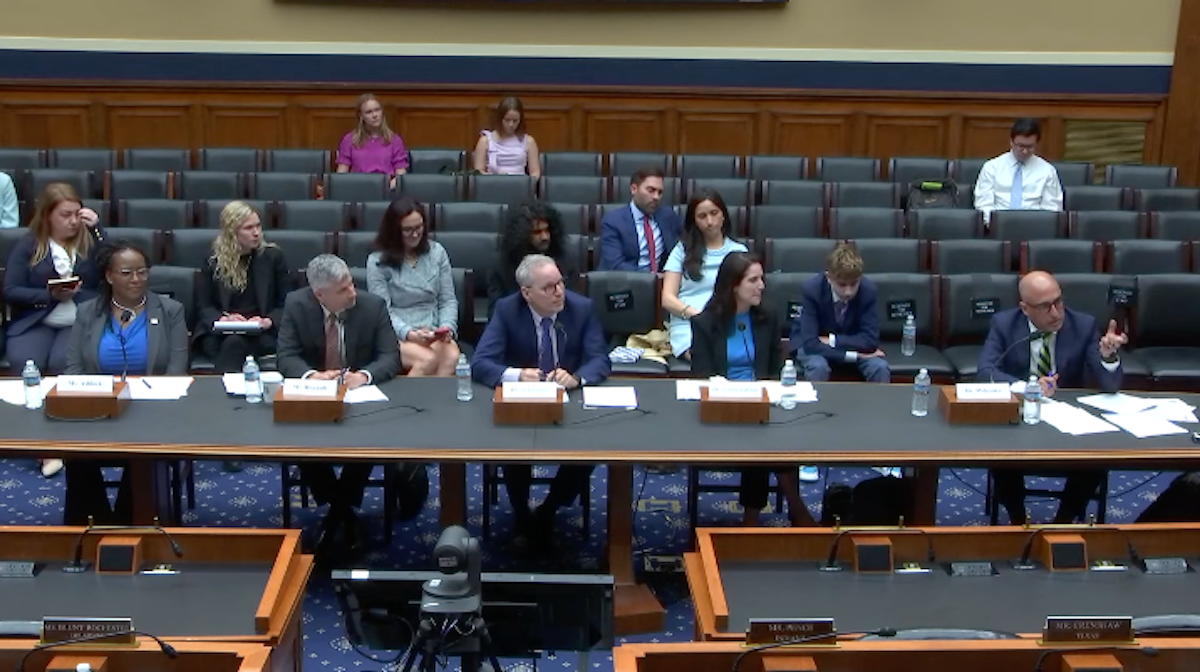News
Article
Telehealth supporters discuss lessons and flexibilities extended from COVID-19 pandemic
Author(s):
House subcommittee is considering at least 15 bills that would affect telehealth.
Witnesses testify during the hearing “Legislative Proposals to Support Patient Access to Telehealth Services,” held April 10, 2024, by the Health Subcommittee of the U.S. House of Representatives’ Energy & Commerce Committee. The House is considering at least 15 bills that would affect various aspects of telemedicine, according to the meeting agenda.

Telehealth has become a core function of health care delivery, not just a nice-to-have addition to medicine, said experts who support permanent allowances for digital delivery of care.
The Health Subcommittee of the U.S. House of Representatives’ Energy & Commerce Committee convened April 10 for “Legislative Proposals to Support Patient Access to Telehealth Services.” The House is considering at least 15 bills that would affect various aspects of telemedicine, according to the meeting agenda.
Telehealth supporters generally want the federal lawmakers and regulators to make permanent the provisions that were granted to expand telehealth services during the COVID-19 pandemic. Those flexibilities were continued in 2023, but many will expire at the end of 2024.
“The looming deadline gives us the chance to examine long-term telehealth solutions that can drive innovation in health care through greater care delivery,” subcommittee Chairman Rep. Brett Guthrie (R-Kentucky) said in his opening remarks.
He specifically mentioned two bills, the Telehealth Modernization Act, which generally would extend the pandemic flexibilities, and the Telehealth Enhancement for Mental Health Act, which would improve Medicare’s delivery of behavioral health services.
Five witnesses spoke in favor of telehealth while providing details about the latest trends in its use.
Easing stress for patients
Going to the doctor is helpful and necessary, and potentially stressful. Telehealth visits allow patients to sit at their kitchen tables with a computer, pen and paper, and written questions when they meet physicians, said Jeanette Ashlock, a patient advocate for the National Multiple Sclerosis Society.
“So often, as soon as you touch that doorknob on a doctor’s office, everything you had in your mind to talk about just melts away, because it can be so stressful,” she said in her written testimony. “And then on the way out the door from the visit, everything you discussed melts away. With my telehealth visits from my house, I am much more relaxed, and able to have much better appointments. It has been so much better for my health all around.”
Policy recommendations
Telehealth for Medicare beneficiaries boomed during the COVID-19 pandemic. Since then, use has declined, although use now Medicare telehealth still is used more broadly than before the pandemic, said Fred Riccardi, president of the Medicare Rights Center. He recommended measures to increase access to care:
- Remove geographic and site restrictions that allow patients with original Medicare to use telehealth in urban areas.
- Pursue an appropriate rate setting, “a delicate but crucial balance,” because if payment is too high, it could jeopardize access to in-person services, but if it is too low, it could jeopardize access to telehealth.
- Examine interactions with other systems, such as the Americans with Disabilities Act and various privacy laws.
- Equalize access for original Medicare and Medicare Advantage.
- Center on beneficiary needs and preferences, which includes access to in-person care, while recognizing that beneficiary preferences vary and evolve.
Reverting to the past?
Ending telehealth payments to established health care providers will cause a reversion to the fragmented services of the pre-pandemic telehealth environment, said Lee Schwamm, MD, professor of bioinformatics and data sciences and neurology at Yale School of Medicine.
“Without certainty of payment for telehealth services, those health care providers who can offer in-person services will only offer in-person services, while those who can only offer telehealth services will continue to offer telehealth services but will target those services only to those who can pay out of pocket,” Schwamm said in his written testimony.
He also emphasized technology, noting Congress should focus on strengthening broadband access for disadvantaged and rural populations, while establishing digital health literacy programs, researching the value of telehealth, and promoting payment for telehealth focusing on chronic disease management and service to disadvantaged populations.
‘Unnecessary guardrails’
With federal flexibilities set to expire, 2024 may be the most consequential year for telehealth policy to date, said Eve Cunningham, MD, MBA, group vice president and chief of virtual care and digital health for Providence health system, serving five states in the western United States.
She noted a number of challenges in telehealth, including the uncertainty of federal timelines and extensions, and program integrity.
“Telehealth is an essential part of health care and should be held to the same standard of care as in-person services,” Cunningham said in her written testimony. “In-person care and telehealth should be used in conjunction to ensure a seamless, efficient and effective health care journey. Telehealth should not be subject to arbitrary and unnecessary guardrails such as in-person requirements, geographic restrictions, brick and mortar requirements or statutory restrictions on services or providers.”
Cost vs. value
Telehealth likely won’t reduce health care spending, but physicians and lawmakers should consider value it delivers, and they should be careful in using one-size-fits-all policies, said Ateev Mehrotra, MD, MPH, professor of health care policy and medicine at Harvard Medical School and a hospitalist at Beth Israel Deaconess Medical Center.
He recommended Congress permanently eliminate site-location requirements and allow video visits for all conditions at any site for any Medicare beneficiaries, with greater allowances for clinicians in federally qualified health centers and rural health clinics. Payment for telehealth also should be lower than in-person visits due to lower overhead for physicians, he said.
Support in Congress
In their comments and questions, none of the legislators flatly opposed telehealth services. They noted and generally praised the swift changes that physicians, other clinicians, and hospitals and health systems made to accommodate patients during the COVID-19 pandemic.
In the hearing lasting more than three hours, at least 28 representatives asked questions largely focusing on quality of care, costs and patient access to medicine, especially in rural areas of the nation. Other queries dealt with physician licensing when doctors care for patients across state lines, patients’ online access, effectiveness of audio-only vs. video visits, and potential fraud and abuse.





